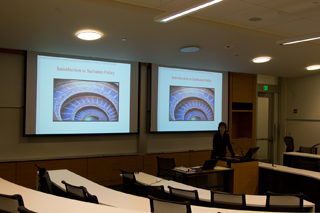|
Subscribe / Renew |
|
|
Contact Us |
|
| ► Subscribe to our Free Weekly Newsletter | |
| home | Welcome, sign in or click here to subscribe. | login |
Construction
| |
 |
August 23, 2012
Schools face pressure to keep up with tech trends
Sparling

Thomas
|
Today’s new educational facilities are being designed and built for the “fully connected” student. Schools need to fully understand the trends in teaching and technology use and their effect on classroom design and curriculum.
Multimedia, interaction and collaboration are no longer desires but requirements in the modern teaching environment. As classroom lectures give way to collaboration and “edutainment,” various implications come into play involving room configuration and technology implementation.
Is technology pushing curriculum changes, or is curriculum demanding technology changes? The debate continues at many schools.
As more tech-savvy instructors are provided with modern tools, they are incorporating technology into their teaching. Thus, instructors are in need of new technologies to teach effectively in this new age.
An instructor who was in love with the idea of incorporating more technology into her courses said recently that she wouldn’t take the time to change her lecture materials if she couldn’t be guaranteed a high-tech classroom every semester. But the main reason for the push toward high-tech classrooms is the institution’s realization that students are demanding new technology in the classroom as the learning experience moves towards edutainment.
Schools that don’t plan for the modern and future student stand to lose them to other institutions or to the distractions of the their own personal high-tech devices.
High-tech pitfalls
For today’s student a laptop or tablet PC is as common as pen and paper. Many students are taking class notes or following an instructor’s lesson on PowerPoint or via electronically posted lecture notes.
Although this is a great benefit for the student’s ability to receive concise notes, many times more technical math and science problems may not be fully worked out step-by-step as in the past on a blackboard or whiteboard. Instructors may be prone to taking shortcuts knowing students have their notes in hand or engaging in the boring practice of merely reading the PowerPoint line by line.
Many instructors are incorporating online homework into their courses. Most students see the move toward the paperless classroom as a great convenience due the reduction of class time spent turning in and receiving homework. However, one common complaint surrounding online coursework is that sometimes online exercises are not graded correctly due to programming errors or other mishaps.
Other instructors are incorporating web media and live interactive-collaboration sessions into their lesson plans as well as online message boards or Twitter-type in-class discussion forums. The use of student response systems has evolved from individual keypads or clickers in the hands of students to voting via web pages that are either password protected or available through a Wi-Fi network that is accessible only from within the classroom.
Annotation tablets and interactive whiteboards are quickly replacing the standard whiteboard. In many larger classrooms, strategically located cameras are being used for image magnification and lecture capture of the instructor, and content for web streaming or posting for student downloading.
The rise of Swype keyboard technology in everyday products such as smartphones and tablet PCs has raised the bar for use of interactive technology in the classroom. Students are expecting to see the same technologies they are using in their everyday life.
Many students bored by standard lectures turn instead to their portable devices and attend to email or social networking during class time. The availability of class notes or captured lectures is also leading some students to skip “boring” classes and review the material online instead.
Changes to classrooms
The desire for increased instructor-to-student and student-to-student interaction has led to changes in the classroom itself. More classroom designs borrow from entertainment venues by incorporating enhanced sightlines, smaller distances between the instructor and the last row, and more circulation space for the instructor.
Large rectangular assembly halls are being replaced by fan-shaped auditoriums. Smaller, more intimate rooms with tiered student seating on an arc are replacing the flat-floor classrooms that have seats in straight rows.
The instructor’s lectern is being reduced in size to remove the barrier between the instructor and student, and the use of wireless microphones, presentation and control technologies are helping to untether instructors from the front of the lecture hall.
Classrooms are being designed to place every student in the optimal viewing area of projection screens and/or large flat panels. Many classrooms now have multiple screens across the teaching wall to allow for content to be displayed while the instructor uses an interactive or standard whiteboard.
The expansion of the Internet and increased network bandwidth has pushed the technology to the level that had only been dreamed of in the early stages of classroom design. Classroom capture, streaming, podcasting and student response technologies now provide students the ability to interact with instructors in the classroom and online.
Webinar capabilities allow instructors to hold classes for a wide student body from a central location. The advent of networked control systems allows these classrooms to be monitored and supported from virtually anywhere on campus.
The discussion of emerging technology and its potential use in the educational environment is always a worthwhile exercise. Many times the “build it and they will come” approach is not the best use of a school’s budget. But investigating potential future uses of new technology and providing the power and infrastructure capability for its incorporation is very beneficial given the long life of a new building versus the rapid change of technology.
Nathan Thomas, an audiovisual consultant for Sparling, has over 23 years of design experience for educational facilities.
Other Stories:
- 5 tips to help districts with their long-range plans
- School contractors face new scrutiny from taxpayers
- UW’s Mercer Court aims to keep students socially connected
- Skills centers making inroads in Washington
- Schools can stretch facilities budgets by embracing technology
- Laser scanning: a powerful tool for school projects
- Portables aren’t the last word in modular schools
- Online learning will have lasting effect on campus spaces



